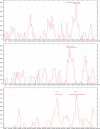Computational detection of genomic cis-regulatory modules applied to body patterning in the early Drosophila embryo
- PMID: 12398796
- PMCID: PMC139975
- DOI: 10.1186/1471-2105-3-30
Computational detection of genomic cis-regulatory modules applied to body patterning in the early Drosophila embryo
Abstract
Background: Regulation of gene transcription is crucial for the function and development of all organisms. While gene prediction programs that identify protein coding sequence are used with remarkable success in the annotation of genomes, the development of computational methods to analyze noncoding regions and to delineate transcriptional control elements is still in its infancy.
Results: Here we present novel algorithms to detect cis-regulatory modules through genome wide scans for clusters of transcription factor binding sites using three levels of prior information. When binding sites for the factors are known, our statistical segmentation algorithm, Ahab, yields about 150 putative gap gene regulated modules, with no adjustable parameters other than a window size. If one or more related modules are known, but no binding sites, repeated motifs can be found by a customized Gibbs sampler and input to Ahab, to predict genes with similar regulation. Finally using only the genome, we developed a third algorithm, Argos, that counts and scores clusters of overrepresented motifs in a window of sequence. Argos recovers many of the known modules, upstream of the segmentation genes, with no training data.
Conclusions: We have demonstrated, in the case of body patterning in the Drosophila embryo, that our algorithms allow the genome-wide identification of regulatory modules. We believe that Ahab overcomes many problems of recent approaches and we estimated the false positive rate to be about 50%. Argos is the first successful attempt to predict regulatory modules using only the genome without training data. Complete results and module predictions across the Drosophila genome are available at http://uqbar.rockefeller.edu/~siggia/.
Figures




References
-
- Davidson EH. Genomic regulatory systems. Academic Press, San Diego. 2001.
-
- Arnone MI, Davidson EH. The hardwiring of development: organization and function of genomic regulatory systems. Development. 1997;124:1851–64. - PubMed
Publication types
MeSH terms
Substances
Grants and funding
LinkOut - more resources
Full Text Sources
Other Literature Sources
Molecular Biology Databases
Miscellaneous

